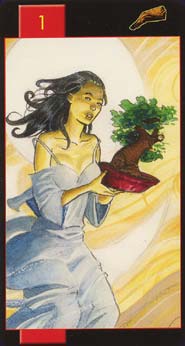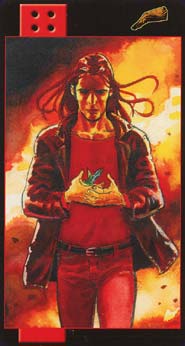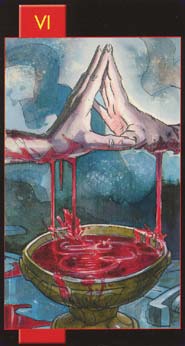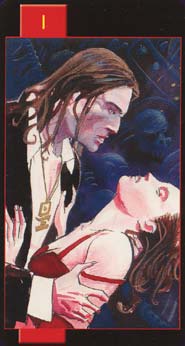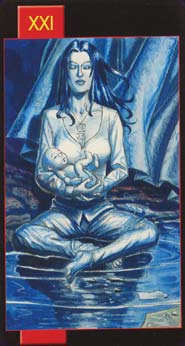Gothic Tarot of Vampires Deck Review
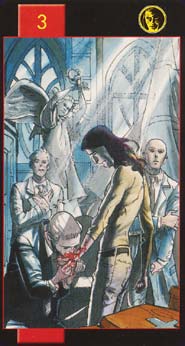
A tarot of the depths - not only the superficial aspects - of the Vampire mythos. Sensual, violent, spiritual, and somber, the Gothic Tarot of Vampires is dark and contemporary and, yes, sometimes bloody.
Deck Type: Tarot Deck Cards: 78
Creators: Riccardo Minetti, Emiliano Mammucari
Publisher: Lo Scarabeo 2003
Retailers
See Price at Amazon.comSee Price at Amazon.ca
Gothic Tarot of Vampires Review by Dan Pelletier
Before I discuss the Gothic Tarot of Vampires, I would like to examine the Vampire mythos. If you have not read "Dracula" for a while you owe it to yourself to go back and re-read it. It's racy, erotic, and considering Bram Stoker published it in 1897, it gives a different light to the story. It reeked of the seductive, and the sensual.
It was a far different story than the 1931 Bela Legosi classic, which lacked the sexuality that the original story contained. However "Dracula" was neither the first nor the finest vampire movie.
In 1922, F.W. Murnau directed "Nosferatu, A Symphony of Horror" with Max Shreck as Count Orlock. It is considered by some to be perhaps the finest Vampire movie ever.
Many view the vampire as a Bela Legosi, or Christopher Lee - or now - Gary Oldman.
But popular culture has lost the essence of the vampire. In the 1978 homage/remake of Murnau's classic by Werner Herzog - Klaus Kinski as the title character Nosferatu utters the line (paraphrased and translated poorly), "Can you imagine what it's like to live for a thousand years, and never feel…love."
And that's an important and overlooked portion of the vampire mythos.
In our western Judeo-Christian culture, we have been raised (whether we admit it or not) that God created man in his own image. As a culture, we shun those who are not god-like. We used to lock them up, institutionalize them, and in some cases murder them.
The popularity of monsters in fiction, be they werewolves or ghosts, is that they are not God-Like as we are. They are not human. We are allowed to hate them, and in ways envy them without guilt.
But the Vampire is also a monster; a former human, now with the fur inside.
We also believe that we were given 'dominion over the birds and beasts'…but the Vampire has moved us down the food chain. Now we are food. And in the role of food, Vampires make a mockery of love, and sex. They can make us want to be food, or take us by force. We no longer rule the food chain.
We are prey.
I credit Ann Rice with bringing a sex, sexuality, and sensuality back into the Vampire mythos. However…to a creature dammed to an eternity in solitude, without knowing an embrace that comes with love…
To only know hunger - and dark - and the grave…
The Vampire mythos is not cute. I doubt if there will ever be a Vampire Barbie. I feel that the mythos is very misunderstood.
Fiona Webster, in discussing the Stephen King book 'Salem's Lot' said; "…King said in 1983, "In 'Salem's Lot', the thing that really scared me was not vampires, but the town in the daytime, the town that was empty, knowing that there were things in closets, that there were people tucked under beds, under the concrete pilings of all those trailers. And all the time I was writing that, the Watergate hearings were pouring out of the TV; Howard Baker kept asking, 'What I want to know is, what did you know and when did you know it?' That line haunts me; it stays in my mind. During that time I was thinking about secrets, things that have been hidden and were being dragged out into the light"."
In Mantia Vol. 8, February 1993, in an article about an unrelated deck we find the line; "Why are we seeking 'The Light', is the question that needs to be answered. Existence is dualistic. Good and evil balances each other"
In "Bruce Almighty," God and Bruce are discussing some of the 'work' that Bruce had done. There is a wonderful line that goes, "Triumph is born out of struggle. Faith is the alchemist. If you want to paint pictures like this, you have to use some dark colours."
I love the Gothic Tarot of the Vampires. It's dark and modern. This deck is not for everybody; it contains the dark colours. I also love the fact that the majors and court cards are not labeled. They are identified numerically.
If you are a strict RWS follower, you may find it difficult to rectify the meanings. When I first took a look at this deck and thought about what the cards mean to me, based on experience and journaling, I found I had to stop and think about each card; only to find that the complexity of the graphics lead me to what I already knew for myself.
I'd like to discuss some of the more disturbing cards. The II card (High Priestess) shows a woman seated in a wing-back chair. Blood runs from her mouth her wrists are slit and bleeding. On the table in front of her is the ghost-shape of a knife and two glasses that appear to be blood smeared. However her expression does not tell of self-mutilation or suicide. It's more of a composed and reflective façade that she presents, along with the half-smile. Is she a vampire or is she the prey? Where does she lie in the food chain? Or perhaps the better question would be…she sits passive, waiting for what will happen, and leans forward slightly in anticipation…of what? This is a picture of active passivity - the opposite of the magician.
The book tells us of Temptation, invitation, the offer of immortality and knowledge…
I often upset folks when I discuss the High Priestess and sex in the same breath - here it is obvious yet subtle - few will notice there are two glasses and both have been drunk from. Where is the second person? Is it us?
Death is the picture used on the card backs. When I first saw it I thought of "the kiss of death." The LWB says, 'the embrace'. Oh my…
Her hair is splayed out. Blood appears around her lips. Her eyes are lifeless…or are they. Blood is around his mouth - and there is a stream of blood/life-force moving from him to her. I get the impression that her days as a human have come to an end…she is about to become, a Vampire…death, rebirth, and transformation. A simple drawing that evokes an eerie passion.
There are a few cards that display the mingling of blood. Back in the days when Native Americans were more prevalent, there was a custom of bonding with blood. I believe that the Celts may have had a similar practice. Bonding with blood is a tie stronger than family. Here we see it displayed with the casualness of a Vampire (2 of Cups). We must think now…if we were Vampires, what would our world look like?
If we were Vampires our world might look like the Four or Wands. Normally the Four of Wands might mean something like, 'Rejoice (ment). Success. A welcoming home and the ensuing happiness; after the struggle and toil.' Here we see a man seated at home. He appears to have committed suicide. A figure appearing as our Vampire protagonist (throughout the deck) kneels in front of him in obvious sorrow. Remember, a Vampire cannot die by slitting their writs…the human gets to 'go home'. The LWB says of this card, "Abandonment, return home…" Get it?
On of my favourite images is the 9 of Wands, which shows a young man kissing an older woman. Her face tells us she has passed on. The picture next to the bed tells us this is a couple. She aged, he did not. She has left him. The LWB tells us, "Losing what is loved, giving importance to things." Wow - This ain't no RWS - this is heady stuff!
The Two of Swords shows a view of a man and woman leaping from a high window. The LWB states, "Test of trust, unity during adversity, taking a chance." Well now that's what a 2 of Swords is supposed to be about!
Oh yeah - the LWB is in four languages, short and to the point, allowing each reader to piece together the pieces of the Vampire metaphor in their own vision.
From the book, "This Tarot deck is necessarily somber, at times gloomy, and sometimes violent. The vampire theme, unless reduced to a superficial stereotype of dress first requires confrontation with blood as well as the fury and relentlessness of a predator, with death and horror."
This is not a deck for everybody. But it's an important deck. And you should look within yourself to see if you should own it. Most likely, you should.
The Six of Swords shows a small girl reaching out and grasping a woman's hand. The girl is about to lead the woman down a walkway of coals…her posture tells the woman (and us), "Come on, you can do it…"
© December 2003, Dan Pelletier
Gothic Tarot of Vampires Review by Kate Hill
The Gothic Tarot of Vampires is a romantic, sensual, dark, contemporary, violent tarot that embraces the both sides of life, dark and light. Drawing on the elegantly damned vampire mythos of Dracula, Anne Rice’s Interview with a Vampire books, movies Dracula, Nosferata, Queen of the Damned, and role-playing game Vampire: The Masquerade.
The card artwork has been created by new artist Emiliano Mammucari, an Italian professional graphic designer, movie buff and comic artist, while the concept and text is by Riccardo Minetti. Minetti also worked on the Fey Tarot, and has long had a passion for the vampire theme.
While this is the ‘Gothic Tarot of Vampires’, these cards don’t use romantic images of vampires in times gone past. The scenery and backgrounds are contemporary and urban: these vampires wear denim jeans, high heels, leather jackets, and inhabit an often bleak and savage world of cars and concrete. As Riccardo writes in the companion booklet:
This tarot is necessarily sombre, at times gloomy, and sometimes violent. The vampire theme, unless reduced to a superficial stereotype of dress (wear black and be handsome and damned), first required confrontation with blood as well as with the fury and relentlessness or a predator, with death and horror.
The card art is dramatic in lighting, focus, and positioning. The backdrops are often pale and in blue tones, as though floodlit, on which the red blood stands out vividly. On my first viewing of the deck, I did find a few of the early cards to be somewhat stomach turning. The High Priestess, who has a bloody mouth and wrists, with more blood in a glass and smeared on the table. (It is gruesome – but she offers you one of the glasses, along with its promise of knowledge and immortality.) There is the Lovers, with their linked hands over a chalice, filling with their mingled blood.
But that’s the worst of it. The bloodiness of some majors leads to the expectation that the rest of the deck will be awash with gore. It isn’t. Once the cards have been mixed with the rest they aren’t as shocking, indeed some, like the calm serenity of the World – a woman holding a baby – are quite lovely. My personal favourite cards are the Three of Chalices, with an elegant woman raising her glass to a vampire hanging from the ceiling and drinking normally. Also, the Seven of Chalices, with it’s seven slickly dressed people lit as though my stage lights, representing the superficiality of image.
Around the central scene, the cards have a black border and no printed titles, which means there is no text to distract the eye and the impact of the images is increased. There is only a number, Roman for majors and Arabic for the minors, while court cards are marked by one to four dots in the top left. The backs show a monochrome image of the Death card.
For use in readings, this deck is non-traditional and doesn’t conform to ‘standard’ symbology. The major arcana portray the essence of the archetype by using vampiric imagery. Of the minors, Chalices reflect the world of mortals, of men, and the relationships the vampire develops with this world. Pentacles represent the vampire’s power and his greater control over the surrounding world. Wands are the natural order, the world to which the vampire does not belong. Swords are the darkest parts of the vampire, the primal urges and violent instincts that drive them.
The companion booklet contains divinatory meanings that are purposely short, intended for the reader can make the connection between the images and meaning themselves, without too much influence from the printed word. There are also two ways to approach these images. “Within the metaphor” means of the vampiric world. “Beyond the metaphor” is the real world, looking past the vampire symbols to how they reflect in human situations.
The Gothic Tarot of Vampires is a modern and dark Tarot with a surprising amount of depth. It is sensual and sometimes violent, but also a poetic and spiritual Tarot deck.
Complete Details of Gothic Tarot of Vampires
Creators: Riccardo Minetti, Emiliano MammucariPublisher: Lo Scarabeo 2003
Deck Type: Tarot Deck
Cards: 78
Major Arcana: 22
Minor Arcana: 56
Deck Tradition: Modern
Minor Arcana Style: Unique Scenes Without Suit Symbols
Suits: Chalices, Swords, Wands, Pentacles
Court Cards: Knave, Knight, Queen, King
The Fool is 0
Strength is 8
Justice is 11
Card Size: 2.60 x 4.72 in. = 6.60cm x 12.00cm
Card Language: Spanish, Italian, German, French, English, Dutch
Card Back: Unknown
Rating: 16/20 or
Similar Decks to Gothic Tarot of Vampires
Theme: Dark & Gothic, VampireCreator: Epic Tarot, Etruscan Tarot, Fey Tarot, Manga Tarot, Manga Tarot Mini, Tarot of the Journey to the Orient by Riccardo Minetti
< Previous Deck · Back to Top · Next Deck >
Home > Tarot Reviews > Gothic Tarot of Vampires Review

